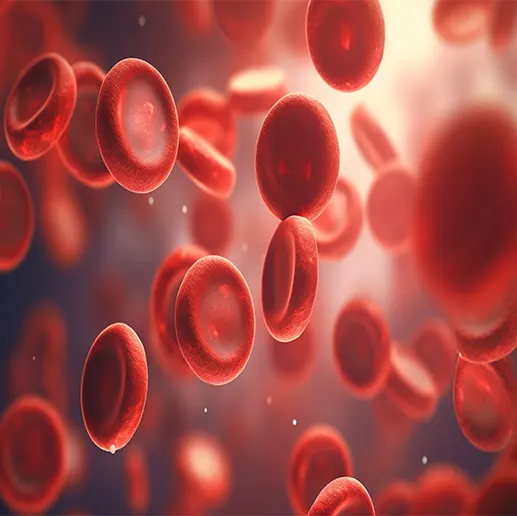What is Mediterranean Anemia? Known medically as thalassemia, it is a hereditary blood disorder caused by a genetic defect in the production of globin chains, which are components of hemoglobin. This condition reduces the oxygen-carrying capacity of red blood cells, leading to anemia. Commonly observed in the Mediterranean region, the Middle East, parts of Africa, and South Asia, this disease may not exhibit significant symptoms in carriers but can cause severe health issues in its advanced forms.
What is Mediterranean Anemia? This disease is inherited in an autosomal recessive manner, meaning that children are at a higher risk of developing the disease if both parents are carriers. There are two main types of Mediterranean anemia: thalassemia major and thalassemia minor. Thalassemia major causes severe anemia, requiring regular blood transfusions and treatment. Thalassemia minor is a mild condition, and carriers often live normal lives without realizing they carry the gene.
The symptoms of thalassemia vary depending on the type and severity of the disease. Common symptoms include:
Symptoms of Thalassemia Minor:
- Mild fatigue,
- Pallor.
Symptoms of Thalassemia Major:
- Extreme fatigue, weakness, and lethargy; pale or yellowish skin,
- Abdominal swelling and pain,
- Facial and cranial bone deformities, weakened and brittle bones,
- Short stature, delayed puberty,
- Frequent infections.

What is Mediterranean Anemia?
Mediterranean anemia arises due to genetic defects affecting hemoglobin production. Hemoglobin is the protein responsible for transporting oxygen in the blood. Insufficient or defective hemoglobin production often results in symptoms of anemia.
These symptoms include fatigue, pale skin, shortness of breath, and dizziness. Particularly in severe cases, symptoms manifest early in childhood.
The root cause of the disease is the body’s inability to produce enough healthy red blood cells. This leads to increased bone marrow activity. The bone marrow, responsible for producing blood cells, enlarges as it attempts to compensate. This enlargement can cause deformities in the facial and cranial bones and weaken the bone structure.
Treatment for Mediterranean anemia varies depending on the severity of the disease. While mild cases may not require treatment, severe anemia necessitates regular blood transfusions. Additionally, chelation therapy is used to prevent iron overload. For some patients, bone marrow transplantation can provide a permanent solution. Thus, anemia treatment must be personalized according to the individual’s overall health and type of disease.
Another critical aspect of the disease is thalassemia carrier status. Carriers live healthy lives without significant symptoms. However, when two carriers have children, the risk of the child inheriting the severe form of the disease increases. Carrier screenings and genetic counseling are crucial for preventing the disease.
Since Mediterranean anemia is a genetic and hereditary condition, early diagnosis and regular follow-ups are vital to improving quality of life.
What Causes Mediterranean Anemia?
Hemoglobin, the oxygen-carrying protein in blood, is located within red blood cells. In thalassemia, defects in hemoglobin production occur due to genetic mutations affecting the alpha or beta chains of the protein. These mutations lead to shortened lifespans of red blood cells and result in anemia.
Since thalassemia is an inherited disorder, it is passed from parents to children. The genetic transmission is described as autosomal recessive, meaning a person must inherit defective genes from both parents to develop the disease. If only one defective gene is inherited, the individual becomes a thalassemia carrier and usually shows no symptoms. However, the risk of severe thalassemia increases for children of two carriers.
Mediterranean anemia is particularly prevalent in the Mediterranean region, the Middle East, Southeast Asia, and Africa. The prevalence of the thalassemia gene in these regions may be linked to its protective effects against diseases like malaria in carriers. However, this protective advantage does not apply to severe forms of thalassemia.
Although the causes of the disease are genetic, symptom severity varies among individuals. Insufficient hemoglobin production decreases oxygen-carrying capacity and causes anemia. To compensate, the body overproduces bone marrow, leading to skeletal deformities and spleen enlargement.
Genetic mutations causing thalassemia can be identified and prevented. Genetic counseling for carriers and prenatal screenings are critical for preventing the disease in future generations.

Mediterranean anemia (thalassemia) is a type of anemia, but not all cases of anemia are Mediterranean anemia. Anemia occurs when the body lacks enough healthy red blood cells.
Thalassemia, on the other hand, is a hereditary condition resulting from genetic mutations affecting hemoglobin production. In this disease, red blood cells break down more quickly than normal, causing severe anemia. Diagnosis of Mediterranean anemia is confirmed through hemoglobin electrophoresis, which analyzes different types of hemoglobin.
Nutrition for anemia treatment depends on the underlying cause of the condition. Thalassemia patients should avoid iron supplements due to the risk of iron overload. However, they are advised to consume foods rich in folic acid, vitamin B12, and protein.
Foods containing vitamin C are beneficial as they enhance iron absorption. Patients should regularly consult their doctors to receive necessary vitamin and mineral supplements. A balanced diet including red meat, green leafy vegetables, legumes, fish, and grains is recommended for individuals with anemia.
Anemia is more common among women, pregnant individuals, children, and malnourished individuals. However, thalassemia, a genetic type of anemia, is more prevalent among individuals of Mediterranean, Middle Eastern, and Asian descent. This disease can be identified through premarital carrier screenings.
Severe forms of thalassemia may lead to symptoms such as spleen enlargement, fatigue, growth retardation, bone deformities, and even flattened nasal bridges. Early diagnosis and genetic counseling are essential for both individual and public health.










